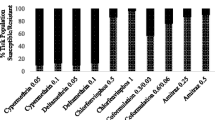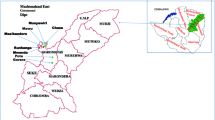Abstract
This study was designed to obtain data on the farmer’s approach to tick control and to determine whether Rhipicephalus appendiculatus Neuman, Amblyomma variegatum (Fabricius), and Rhipicephalus (Boophilus) microplus (Canestrini) were resistant to amitraz and cypermethrin acaricides, in Isoka District, Zambia. Prevailing tick control practices were documented by administering a semi-structured questionnaire to 80 randomly selected smallholder livestock farmers from four agricultural camps (Longwe, Kantenshya, Kapililonga, and Ndeke) in Isoka District. Modified larval packet test (LPT) bioassay experiments were used to determine the resistance status of the common tick species against amitraz and cypermethrin acaricides. Fifty percent of respondents practiced chemical tick control with amitraz (27 %) and cypermethrin (23 %) being the acaricides in use, and were applied with knapsack sprayers. Less than 3 l of spray wash per animal was used which was considerably lower than the recommended delivery rate of 10 l of spray wash per animal. No significant susceptibility change to amitraz at 95 % confidence level was observed in R. appendiculatus and A. variegatum against amitraz. However, a significant change in the susceptibility of R. (Bo.) microplus tested with amitraz was detected at 95 % confidence. The test population had a lower susceptibility (LD50 0.014 %; LD90 0.023 %) than the reference population (LD50 0.013 %; LD90 0.020 %). The results indicated that resistance to amitraz was developing in R. (Bo.) microplus. For cypermethrin, no significant susceptibility change at 95 % confidence was observed in any of the three species and thus resistance to this chemical was not observed.

Similar content being viewed by others
References
Abbas, R.Z., Zaman, M.A., Colwell, D.D., Gillard, J. and Iqbal, Z., 2014. Acaricide resistance in cattle ticks and approaches to its management: the state of play. Veterinary Parasitology, 203(1–2), 6–20.
Abdullah, S., Yadav, C.L. and Vatsva, S., 2012. Esterase profile of Rhipicephalus (Boophilus) microplus population collected from northern India exhibiting varied susceptibility to deltamethrin. Experimental and Applied Acarology, 58, 315–325.
Adakal, H., Stachurski, F. and Chevillon, C., 2013. Tick control practices in Burkina Faso and acaricide resistance survey in Rhipicephalus (Boophilus) geigyi (Acari: Ixodidae). Experimental and Applied Acarology, 59, 483–491.
Ayres, D.R., Pereira, R.J., Boligon, A.A., Silva, F.F., Schenkel, F.S., Roso, V.M. and Albuquergue, L.G., 2013. Linear and poisson models for genetic variation of tick resistance in cross-bred Hereford × Nellore cattle. Journal of Animal and Breeder Genetics, 130, 417–424.
Bianchi, M.W., Barre, N. and Messad, S., 2003. Factors related to cattle infestation level and resistance to acaricides in Boophilus microplus tick populations in New Caledonia. Veterinary Parasitology, 112, 75–89.
Brito, G.L., Barbieri, F.S., Rocha, R.B., Oliveira, M.C.S. and Ribeiro, E.S., 2011. Evaluation of the efficacy of acaricides used to control the cattle tick, Rhipicephalus microplus, in dairy herds raised in the Brazilian South Western Amazon. Veterinary Medicine International, 806093.
Campbell, M.J., 2005. Sample size determination in clinical trials. In Encyclopaedic Companion to Medical Statistics Eds: Everitt BS and Palmer CR: Hodder Arnold, 302–306.
Caracostantogolo, J., Munoz Cobenas, M.E., Eddi, C., Ambrustolo, R.R., Bulman, G.M. and Marangunich, L., 1996. Primera deteminacion en la Republica Argentina de una poblacion de Boophilus microplus (Can.) resistente al piretroide sintetico alfacipermetrina caraterizada mediante pruebas preliminares., Veterinary Argentina, 13, 575–582.
Corley, S.W., Jonsson, N.N., Piper, E.K., Cutullé, C., Stear, M.J. and Seddon, J.M., 2013. Mutation in RmBAOR gene is associated with amitraz resistance in the cattle tick Rhipicephalus microplus. Proceedings of the National Academy of Sciences USA, 110 (42), 16772–16777.
Cutullé, C., Lovis, L., D’Agostinoc, B.I., Balbiani, G.G., Morici, G., Citroni, D., Reggi, J. and Caracostantogolo, J.L., 2012. In vitro diagnosis of the first case of amitraz resistance in Rhipicephalus microplus in Santo Tomé (Corrientes), Argentina. Veterinary Parasitology, 192, 296–300.
Ducornez, S., Barré, N., Miller, R.J. and de Garine-Wichatitsky, M., 2005. Diagnosis of amitraz resistance in Boophilus microplus in New Caledonia with the modified Larval Packet Test. Veterinary Parasitology, 130, 285–292
Enayati, A.A., Asgarian, F., Amouei, A., Sharif, M., Mortazavi, H., Boujhmehrani, H. and Hemingway, J., 2010. Pyrethroid insecticide resistance in Rhipicephalus bursa (Acari: Ixodidae). Pesticide Biochemistry Physiology, 97, 243–248.
Esemu, S.N., Besong, W.O., Ndip, R.N. and Ndip, L.M., 2013. Prevalence of Ehrlichia ruminatium in adult Amblyomma variegatum from cattle in Cameroon. Experimental and Applied Acarology, 59, 377–387.
Estrada-Pena, A. and Salman, M., 2013. Current limitations in the control and spread of ticks that affect livestock: A review. Agriculture., 3, 221–235.
FAO. 1984. Acaricide resistance, pp. 246–299. In Ticks and tick-borne disease control. A practical field manual, vol. 1. Tick control. FAO, Rome.
Freeman, J.M., Davey, R.R., Kappmeyer, L.S., Kammlah, D.M. and Olafson, P.V., 2010. Bm 86 midgut protein sequence variation in south Texas cattle fever ticks. Parasites and Vectors, 3, 101.
George, J.E., Davey, R.B. and Pound, J.M., 2004. Chemical control of ticks on cattle and the resistance of these parasites to acaricides. Parasitology, 129, S353-S366.
Heong, K.L., Tan, K.H., Fabellar, L.T. and Garcia, C.P., 2010. Research methods in toxicology and insecticide resistance monitoring of rice plant hoppers. Technical report.
Jongejan, F. and Uilenberg, G., 2004. The global importance of ticks. Parasitology, 129, S3–S14.
Kunz, S.E. and Kemp, D.H., 1994. Insecticides and acaricides: Resistance and environmental impact. Revue scientifique et technique Office International desEpizooties., 13, 1249–1286.
Li, A.Y., Davey, R.B., Miller, R.J. and George, J.E., 2004. Detection of amitraz resistance in the southern cattle tick, Boophilus microplus (Acari: Ixodidae). Journal of Medical Entomology, 41, 193–200.
Luguru, S.M., Chizyuka, G.B. and Musisi, F.L. 1987. A survey for resistance to acaricides in cattle ticks (Acari: Ixodidae) in three major traditional cattle areas in Zambia. Bulletin of Entomological Research, 77, 569–574.
Mendes, M.C., Pereira, J.R. and Prado, A.P., 2007. Sensitivity of Boophilus microplus (Acari: Ixodidae) to pyrethroid and organophosphate in farms in the Vale Do Paraiba regions of SAO Paulo. Brazil and Argentina Institute of Biology, 74, 84–85.
Mekonnen, S., 2002. Acaricide resistance profiles of single and multi-host ticks in commercial and communal farming areas in the Eastern Cape and Northwestern Provinces of South Africa. M.V.Sc. Dissertation, University of Pretoria.
Meyer, J.M., Ejendal, K.F., Avramora, L.V., Garland-Kuntz, E.E., Giraldo-Calderon, G.I., Brust, T.F., Watts, V.J. and Hill, C.A., 2012. A genome to lead approach for insecticide discovery: pharmacological characterization and screening of Ades aegypti D (1) like dopamine receptors. PLoS Neglected Tropical Diseases, 6, 478.
Miller, R.J., Davey, R.B. and George, J.E., 2002. Modification of the food and agriculture organization larval packet test to measure amitraz-susceptibility against Ixodidae. Journal of Medical Entomology, 39, 645–651.
Miller, R.J., Davey, R.B., Hunter White, W. and George, J.E., 2007. A comparison of three bioassay techniques to determine susceptibility in Boophilus microplus (Acari: Ixodidae). Journal of Medical Entomology, 44, 283–294
Mooring MS, McKenzie, A.A. and Hart, B.L., 1996. Grooming in impala: role of oral grooming in removal of ticks and effects of ticks in increasing grooming rate. Physiology and Behaviour 59:965–971
Moyo, B. and Masika, P.J., 2009. Tick control methods used by resource-limited farmers and the effect of ticks on cattle in rural areas of the Eastern Cape Province, South Africa. Tropical Animal Health and Production, 41, 517–523.
Muchenje, V., Dzama, K., Chimoyo, M., Raats, J.G. and Strydom, P.E., 2008. Tick susceptibility and its effects on growth performance and carcass characteristics of Nguni, Bonsmura and Angus steers raised on natural pasture. Animal., 2, 298–304.
Ntondini, Z., van Dalen, E.M.S.P. and Horak, I.G., 2008. The extent of acaricide resistance in 1-, 2- and 3-host ticks on communally grazed cattle in the eastern region of the Eastern Cape Province, South Africa. Journal of the South African Veterinary Association., 79(3), 130–135.
Pirali-Kheirabadi, K., Haddadzadeh, H., Razzaghi-Abyaneh, M., Bokaie, S., Zare, R., Ghazavi, M. and Shams-Ghahfarokhi, M., 2007. Biological control of Rhipicephalus (Boophilus) annulatus by different strains of Metarhizium anisopliae, Beauveria bassiana and Lecanicillium psalliotae fungi. Parasitological Research, 100, 1297–1302
Rajput, Z.I., Hu, S., Chen, W., Arijo, A.G. and Xiao, C., 2006. Importance of ticks and their chemical and immunological control in livestock. Journal of Zhejiany University Science B., 7, 912–921.
Robertson, J. L., Russell, R. M., Preisler, H.K. and Savin, N.E., 2007. Bioassays with arthropods. 2nd ed. CRC Press, Tayor and Francis Group, New York.
Roush, T.R. and McKenzie, J.A., 1987. Ecological genetics of insecticide and acaricide resistance. Annual Review of Entomology, 32, 361–80.
Sajid, M.S., Iqbal, Z., Khan, M.N., Muhammad, G. and Iqbal, M.U., 2007. Effect of Hyalomma ticks (Acari: Ixodidae) on milk production of dairy buffaloes (Bos Bubalus Bubalis) of Punjab (Pakistan). Italian Journal of Animal Science 6:939–941
Thullner, F., Willadsen, P. and Kemp, D., 2007. Acaricide rotation strategy for managing resistance in the tick Rhipicephalus (Boophilus) microplus (Acarina: Ixodidae): laboratory experiment with a field strain from Costa Rica. Journal of Medical Entomology, 44, 817–821.
Walker, A.R., Bouattour, A., Camicas, J.L., Estrada-Peña, A., Horak, I.G., Latif, A.A., Pegram, R.G. and Preston, P.M., 2007. Ticks of domestic animals in Africa: a guide to identification of species. Bioscience Reports, Edinburgh.
Yilima, J., Adamu, G. and Zerbini, E., 2001. Biossay of acaricide resistance on three tick species at Holotta, Central Ethiopia. Revue Médecine Vétérinaire, 152(5), 385–390.
Yambayamba, K.E., Mukumbuta, W.M., Chileshe, E.C., Simainga, S. and Chonde, D., 2003. Assessment of the existing livestock status and production systems in the ASP operational areas. Technical report.
Zaman, M.A., Iqbal, Z., Abbas, R.Z., Khan, M.N., Muhammad, G., Yonnas M. and Ahmed, S., 2012. In vitro and in vivo acaricidal activity of a herbal extract. Veterinary Parasitology, 18, 431–436.
Acknowledgments
The authors wish to acknowledge financial support from the Ministry of Agriculture and livestock, Zambia. They also extend their thanks to Tedwell Mulutula, Boniface Mulima, Alfred Siame and Gilbert Munongo (Veterinary Assistants, Isoka District) whose kind assistance made this work possible. Similar thanks also go to Dr Hachamba (Veterinary Officer, Isoka District) who allowed use of his staff during the course of this work. Lastly, we thank all members of the farming community in Isoka District for their willingness to participate in the survey and allow their animals to be sampled for the study.
Statement of human and animal rights
Informed consent was obtained from all individual participants included in the study. All applicable international and national guidelines for the care and use of animals were followed.
Conflict of interest
The authors declare that they have no competing interests.
Author information
Authors and Affiliations
Corresponding author
Rights and permissions
About this article
Cite this article
Muyobela, J., Nkunika, P.O.Y. & Mwase, E.T. Resistance status of ticks (Acari; Ixodidae) to amitraz and cypermethrin acaricides in Isoka District, Zambia. Trop Anim Health Prod 47, 1599–1605 (2015). https://doi.org/10.1007/s11250-015-0906-4
Received:
Accepted:
Published:
Issue Date:
DOI: https://doi.org/10.1007/s11250-015-0906-4




